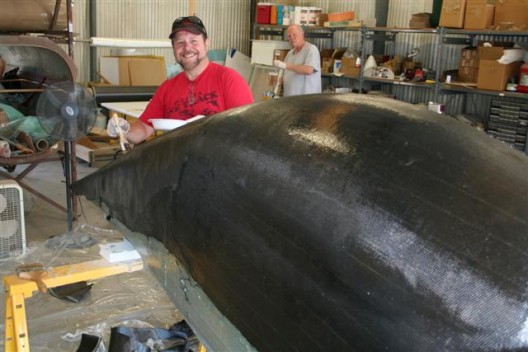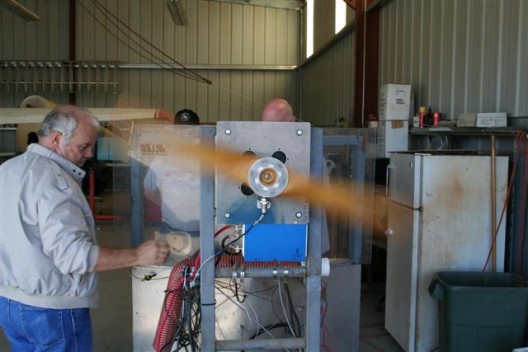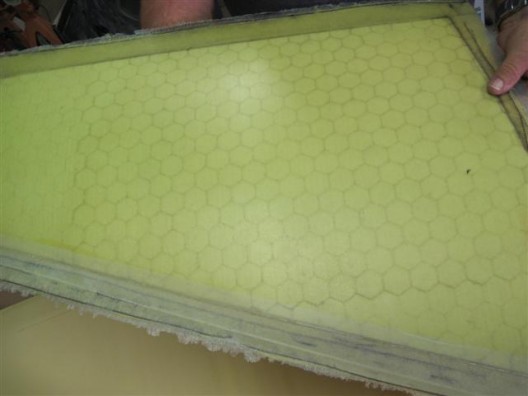But it will be the Feuling Green Flight Challenger, an entirely new iteration of the Quickie “formula” if Gene Sheehan, Vic Turner, Luke Leatherman and Allon McBee have their way. Created in the wake of the Vari-Eze’s and Long-Eze’s of the early 1970’s, the original Quickie was an 18-horsepower Onan industrial engine-powered irreducible flying machine with great speed for its low power and unbelievable fuel economy. The team’s GFC Challenger is electric, and a far cry from its cast iron past – or the iron-horse Harley-Davidson motorcycles that are part of its surroundings.
“Feuling” comes from the high-performance motorcycle and automobile developer who started the company bearing his name. Jim Feuling had over 100 patents to his name, worked with the big names in the racing world, and created a 500 mile-per-gallon engine (at 55 miles per hour) for Honda’s streamliner and fielded a record-breaking motorcycle streamliner that clocked 333.847 mph on the Bonneville Salt Flats on October 20th, 1999. The most famous product of that part of the Feuling empire may be the W3 engine, a performance enhancement for Harleys that places an additional cylinder between the normal two, changing the V-twin to a W-3. Tuned mildly, and extremely well balanced, the 2,458 cc engine puts out 150 reliable horsepower and very little of the thump that shakes two-cylinder H-D frames and those of their riders. Jim Feuling died in 2002, but the company, now Mojave based, continues to make twin-cam accessories.
In a conversation with Gene Sheehan, he explained that he had made serious inroads into creating a modern Quickie with a new industrial V-twin engine, noting that the fuel burn was low enough to make it GFC competitive. Weighing his options (quite literally), he decided that the original’s 95-pound Onan and its 48 pounds (eight gallons) of fuel could be replaced by a 25-pound electric motor and 70 pounds of batteries to suit the requirements of the Challenge. Gene describes the issue of battery weight as a “curse” in terms of staying within airframe limits.
With new carbon-fiber cloth, a confidential honeycomb material, and careful weight management on the wet layups, the Green Flight Challenger could be not only structurally lighter than the original, but an attractively-priced competitor. Team Feuling anticipates an empty weight of 240 pounds for the slightly smaller-than-original Quickie airframe. Gene estimates $25,000 for airplane, motor, batteries and all, arguably the lowest cost of any aircraft in the GFC.
Where the original Quickie had a leisurely rate of climb, the Green Flight Challenger will have to meet the takeoff and landing dictates of the Challenge rules, including clearing a 50-foot obstacle within 2,000 feet of brake release. Gene assures that this will be part of the airplane’s capabilities. Quickie’s seating and visibility easily fall within GFC parameters, illustrating the far-sighted nature of the original design.
Electric power brings the additional advantage of lowered cooling drag, possibly as little as 15 to 25 percent of that for chilling out the original’s internal-combustion engine, according to Luke Leatherman. The 90 percent or greater efficiency of most modern electric motors means they squeeze the most out of every kilowatt hour from their batteries, making up somewhat for the energy-to-weight ratio of most packs.
Natural Laminar Flow (NLF) airfoils will replace the more turbulent originals, adding to the sleekness of the overall craft and improving speed and economy.
Having seen a resurgence of interest in the gas-fueled Quickie, Gene Sheehan believes that the Green Flight Challenger has the potential to be a marketable airplane. He sees it as a great “airport flyer” for building time, with handling characteristics that make it pilot’s airplane. At a dollar or so per recharge for an hour or two of flying, this craft would definitely have a following. Gene notes that airports will need to build a charging station infrastructure to support the coming wave of electric aircraft.
Vic Turner, an early Quickie customer and winner of the first CAFE challenge and several Lowers-Baker-Falck contests at Oshkosh, will provide race-winning experience for the team.
With the combination of expertise, a refined airplane and a high level of enthusiasm, the Team looks forward to flying their entry from Mojave to the Green Flight Challenge at Santa Rosa’s Charles M. Schulz Sonoma County Airport next July, possibly in one hop. They will compete against other, equally dedicated teams, but few will have as much fun getting there.





Comments 11
Sounds like a great project.
I too am considering an electric airplane. In my case it starts out as a Wittman Buttercup – 2 seats and max LSA performance. I already have found one vendor for the motor and controller – Yuneec. They offer 85 hp in a kit including the batteries I need for a couple hours cruise for around $20,000. I’m hoping the two years or so from now until I am actually ready to start buying and installing the electric stuff will allow all those automotive folks to come up with even better batteries for less money.
Any comments you wish to make regarding the power plant and batteries would be greatly appreciated.
Thanks,
Paul Mulwitz
Camas, WA
This is really exciting. I strongly believe that electric flight is the future. I would like to learn more about this effort and might possibly be a future customer.
I think the quickie has an efficient shape. However, instead of using a single puller propeller, airflow is much more efficient if both a puller and a pusher propeller are used (as in Voyager, the Dornier 335, etc,). Only half as much air would be forced by the puller prop on the fuselage, wings, etc, and the air would be reaccelerated by the pusher propeller immersed in the wake. Also using a series of very light, hollow, plastic ogives along the wings’ leading edges would allow the plane to take off at a higher angle (providing STOL, to clear the 50′ obstacle), without stalling (like the bumps on the fins of a humpback whale). The ojives would also improve laminar flow while cruising.
What airfoil are you guys using? I am a quickie fanatic and am interested in this aircraft.
Does anyone know if the Feuling Challenger carbon electric-quickie ever flew? If so, how did it do?
Lou Levison
Klamath Falls, OR
(Editor’s Note: It flew and quite well, according to its developers. It was unable to participate in the GFC because of a landing gear mishap, but did fly afterwards. Your editor will inquire as to its current status, since it would make a great homebuilt with electric power.)
Any update on this super exciting quickie? any plans available for the home builder?
Thanks 🙂
Interesting story. Would like more info on the build. Referring to the switch from fiberglass to Carbon fiber, which is what I would like to build a Q out of.
I personally saw the electric quickie fly several times. Call Gene and tell him you want to see this awesome airplane fly again soon!!
ELECTRIC is nice, but Motor’s and Batteries are too Much!
Carbon Fiber is nice, but makes it too Exspensive also!
Make this in cheaper Fiberglass with a Hirth 28hp, or Rotax 277 26hp, or a Rotax 377/380 35hp, 447 40hp, or 503 50 hp, and it will SELL! People have even put a Skidoo 583 97hp on a old Quickie(Q1).
Hirth 28hp F-33 with Recoil Start $2857.00
Hirth 28hp F-33 with Recoil Start & 4V Belt Drive $3427.00
Hirth 28hp F-33 with recoil & Electric start & 4V Belt Drive $3778.00
Simonini makes Singles in 44hp, 48hp, 54hp today!
Thor is making some nice Singles also!
Any thing happen in last 3 years like parts plans
Any thing happen in last 3 years if u put the new Honda gx390 enginein it or the one that is put in the Chevy volt premier will be good